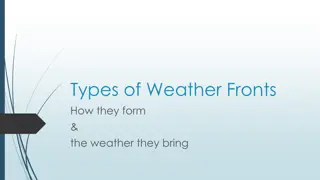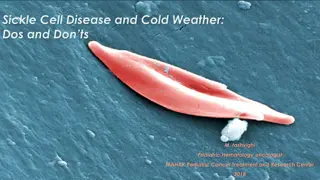Understanding Cold Fronts and Occluded Fronts in Weather Systems
Cold fronts occur when advancing cold, dry air displaces warm, moist air, causing changes in temperature, winds, precipitation, and pressure. Occluded fronts result from a cold front overtaking a warm front, leading to the formation of mid-latitude cyclones. Different types of occlusions, like the cold-type occluded fronts, can influence weather patterns and meteorological phenomena.
Uploaded on Oct 05, 2024 | 0 Views
Download Presentation

Please find below an Image/Link to download the presentation.
The content on the website is provided AS IS for your information and personal use only. It may not be sold, licensed, or shared on other websites without obtaining consent from the author. Download presentation by click this link. If you encounter any issues during the download, it is possible that the publisher has removed the file from their server.
E N D
Presentation Transcript
Cold Fronts A the atmosphere where an advancing cold, dry stable air mass displaces a warm, moist unstable subtropical air mass. On a weather map, the cold front is drawn as a solid blue line with triangles. The position of the triangles shows the direction of frontal movement. Cold fronts move between 15 to 50 kilometers per hour in a southeast to east direction. The formation of clouds and precipitation at the frontal zone is caused by frontal lifting. High altitude cirrus clouds are found well in advance of the front. Above the surface location of the cold front, high altitude cirrostratus and ltitude altocumulus are normally found just behind the front where frontal lifting has caused towering cumulus and cumulonimbus clouds# cold front is the transition zone in middle common. Precipitation is the development of
Cold Fronts . . 50 . . . cirrostratus . . 15
Identification and Frontal Weather Weather Element Before Passage During Passage After Passage Temperature Warm Sharp drop Colder Winds South or southwest Variable and gusty West or northwest Precipitation None or showers Thunderstorms in summer, rain or snow in winter Clearing Clouds None, cumulus, or cumulonimbus Cumulonimbus None or cumulus in summer Pressure Falling then rising Rising Rising Humidity High, particularly in summer Dropping Low, particularly in winter
Occluded Front Helps to Generate a Mid-Latitude Cyclone when a cold front overtakes a warm front A developing cyclone typically has a preceding warm front (the leading edge of a warm moist air mass) and a faster moving cold front (the leading edge of a colder drier air mass wrapping around the storm). North of the warm front is a mass of cooler air that was in place before the storm even entered the region.
Occluded Front Helps to Generate a Mid-Latitude Cyclone ) ( .) . (
Types of Occlusion- Cold-Type Occluded Fronts During the formation of an occluded front, the Bergen meteorologists believed that if the polar air behind the cold front was colder (and thus denser) than the polar air ahead of the warm front, then this less dense air and the associated warm front would ride up off the ground over the cold front as the occluded front formed. This type of structure is called a cold-type occlusion.
Types of Occlusion- Cold-Type Occluded Fronts . ) ( .
Warm-Type Occluded Fronts A warm air occlusion or occluded front is less common than a cold occlusion. A warm occlusion occurs as cool air moves rapidly into an area with an existing warm front. The difference from a cold occlusion is that the approaching cool air is not as cold as the retreating cold air in the existing front. In other words, the fast-moving, incoming air is cold, but not as cold as the air mass ahead of it. Precipitation can usually be expected when an occluded front passes through an area.
Warm-Type Occluded Fronts . . . . .
Winds southeast-south variable west to northwest Temperature Cold Type Warm Type Pressure cold-cool cold dropping rising colder milder usually falling low point usually rising Ns, sometimes Tcu and Cb Clouds in order: Ci, Cs, As, Ns Ns, As or scattered Cu light, moderate or heavy continuous precipitation or showers light-to-moderate precipitation followed by general clearing light, moderate or heavy precipitation Precipitation Visibility poor in precipitation poor in precipitation improving usually slight drop, especially if cold- occluded slight drop, although may rise a bit if warm- occluded Dew Point steady























